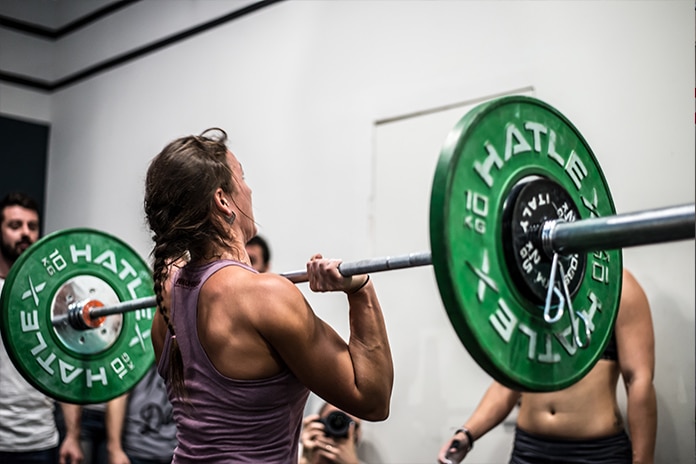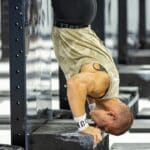Push it real good—ideally overhead, with a barbell in hand. The strict press, push press and push jerk are natural progression movements that all have a place in the box. Each differs slightly from the other, and we can often get confused on which is which. That’s why we’ve developed a quick and dirty guide for your pressing movements.
The Strict Press
The strict press. also called the shoulder press, is a pure strength and muscle-building exercise. Specifically, it targets the shoulder muscles and develops your overhead pushing strength.
Start with your hands just outside the shoulders, wrists stacked on top of the elbows with a
neutral spine (as pictured to the right). Then, simply press overhead. As the name implies, it’s a strict press, so there will be no dip to generate power from your legs. The bar should finish directly over your shoulders. You’ll return to your start position by reversing this motion. The strict press is the least technical of the three variations we’ll be discussing in this article.
Things to keep in mind:
• Keep a tight core. There’s a tendency to arch the lower back at the top of this movement, putting unnecessary stress on the lumbar spine. Keep that tailbone tucked and the core engaged.
• The bar should rest on the palm of the hand, not in the fingers. You have a lot more stability on the palm, and this protects your wrists.
• Note that this movement does not start in a “front rack” position. Your forearms should be vertical.
When to incorporate: While they will come up in the rare metcon, strict presses are ideal for building upper body strength to better perform more technical lifts as well as gymnastics movements. You’ll notice stronger handstand push-ups, kip swings and butterfly pull-ups with this old standby in your training.
The Push Press
A popular metcon staple, the push press is similar to a strict press, but it brings the lower body to the party. You’ll initiate a push press with a dip in the legs and then transfer that momentum into an upward drive that helps thrust the bar from the shoulders to the overhead lockout position. The dip-drive should be quick, just enough to get momentum going under the bar. You will be able to move more weight with a push press than with a strict press.
Things to keep in mind:
• We’re not looking for a front squat. Think about the dip-drive like you went to sit down and you hit a tack. Controlled down, drive up.
• When repping out several push presses in a workout, make sure you are locking out elbows at the top every time and using the end of a rep to push you into the next dip-drive. Work smarter, not harder.
When to incorporate: Push-presses are often seen in metcons because they’re quick and somewhat easy to do in large volumes.
The Push Jerk
You’ll be able to move the most amount of weight with a push jerk. Like other Olympic lifts, the push jerk involves dropping your body under the barbell. You’ll incorporate the same midline stability, bar path and dip-drive of the push press, but you’ll be adding a second knee bend to receive the bar. After the dip-drive and hip extension to get the bar moving, you will “punch” yourself under the barbell, landing locked out in a slight overhead squat. The lift is completed when you stand tall with the bar overhead.
Things to keep in mind:
• You’ll start this lift with elbows slightly in front of the bar, in more of a front rack position.
• This may be a movement where those with larger or longer arms may prefer a slightly wider grip.
• It can be easy to dip in a bad position when all your focus is on bringing the bar overhead. Remember to drive the knees out.
When to incorporate: The push jerk is a useful introduction to overhead Olympic lifting and could be used as part of a clean and jerk, as well as in metcons with heavy shoulder-to-overheads. Don’t use more energy than necessary if there is no specification on how to get the bar overhead—use a push jerk.
Photo credit: Rafael López/ CC BY-NC -ND 2.0














